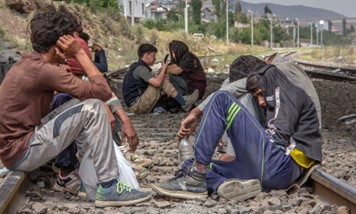1. INTRODUCTION
In the whole Indian subcontinent, there is discrimination towards women; in particular, women during menstruation are considered impure and dirty. The conception of the period as dirty and impure leads to exclusion of women from religious, social, and cultural life. Anything women touch during menstruation becomes polluted and therefore not usable by someone else. Thus, during menstruation women are not allowed to enter the kitchen or cook, touch plants or animals, drink milk, or eat dairy products.
In the specific case of Nepal, these restrictions reach their peak in a practice called Chāupadi, one of the most extreme forms of menstrual isolation. Women are forced into confinement during their menstruation, often to protect the male members of the family, who would risk contamination. In rural areas, where this practice is the most widely spread, there is no place in the house where women can isolate themselves and, for this reason, they are forced to live in animal huts (lit. Chāughat).
Although practices and beliefs are slowly changing, and despite the practice of Chāupadi being declared illegal by the Supreme Court in 2015, this extreme confinement continues to persist especially in rural areas of Achham district and Jumla district.
The essay analyzes some concepts necessary for an understanding of the phenomenon. The first part introduces the social context in which the practices of menstrual confinement are embedded: the caste system and gender discrimination in the Indian subcontinent. Then, a specific case of Chāupadi is analyzed in an attempt to challenge the common belief that the most “barbaric” practices are more present in the most remote places while being absent in urban areas.
Finally, the essay provides an example of action in order to combat practices such as the menstrual confinement, with the aim of seeing a possible way to cross the borders of tradition. The practice of Chāupadi, in Nepal, reflects deep cultural issues. The impurity of menstruation does not allow women to discuss the issue freely, but neither allow them to question or reject the practice. The example of action that will be cited later demonstrates how, in the case of menstrual confinement, women must cross an invisible cultural border of certain traditional norms in order to interrupt a practice, which often puts their lives at risk.

Photo credit: Photo©Poulomi Basu/VII Mentor
Thyra Khuri Bishwa Karma, 16 years, Narsi village
“ I get scared of snakes. There is a village called Mumuri where a girl got bitten an when people come and see us at the chaupadi. I feel ashamed. I feel so ashamed.”
2. DISCRIMINATION AGAINST WOMEN: THE IMPURITY OF MENSTRUATION
Indian society is divided into 4 varṇa (social classes), a Sanskrit word that literally means color: brāhmaṇa, the priests who perform religious functions; kṣatriya, those who carry out political-administrative functions; vaiśya, the common people; and śūdra, a caste made up of those who have the task of serving the other three classes. each class contains within it many jāti (castes). Belonging to a caste is established by birth; however, it is also possible to improve one’s own status. Generally, there are strategies adopted by the low castes that involve the assimilation of the behaviors of the higher castes.
Outside the caste system there are the so-called ‘untouchables’ – or dalits, a term that literally means “oppressed” – who make up about 16% of the Indian population, according to the 2012 census. Dalits are marginalized by the other four castes and considered by them unclean. Hence, the idea of untouchability: everything touched by a Dalit, in fact, is considered contaminated and cannot be touched by a person of a higher caste. In case contacts occur accidentally, it is necessary to perform purification rituals. Although the caste system was abolished in 1950, it continues to condition the life of many people in India today. Within this system, women are equally discriminated, and they are considered inferior to men, while an untouchable woman suffers double discrimination, based on sex and caste. As a matter of fact, the earliest Indian documents demonstrate a certain equality between men and women. In the Manusmṛti – a Hindu treaty of law dating from the II century. B.C. and II A.D. – the social role of a woman is clearly defined. In the ninth chapter, in particular, it is stated that a woman is not suitable for her independence: her father must look after her during childhood, her husband in his youth and her children in old age. In some places, the female figure is also glorified and honored, but whatever dignity or honor a woman enjoys, the code of laws reveals that she has no real power. Furthermore, for women, only domestic and religious education is favored, as well as training in music and dance so that she can satisfy her man. It should be noted, however, that this is a text that lists ideal behaviors, and there is no certainty of its actual use as a code of laws. A powerful form of discrimination against women occurs during the time of menstruation.
The menstrual cycle is a natural process, part of the reproductive cycle, in which blood comes out from the uterus through the vagina. It occurs for the first time in girls usually between 11 and 14 years of age and marks the onset of puberty. However, in most of the societies around the world, menstruation has always been surrounded by secrets and myths, and has often been considered a taboo. This has led to the construction of traditional beliefs related to the impurity of menstruation. This resulted in a lack of knowledge of the process, especially among young girls, and a reluctance to discuss it normally[1].
In the Indian subcontinent, menstruation is still considered unclean and dirty today. The mythic origin of the menstruation’s impurity dates back to Vedic times and is often linked to Indra’s[2] killing of Vritras[3]. It has been declared in the Vedas, in fact, that women have taken part of Indra‘s blame for the killing of a brahmin and are thus punished every month through the menstrual flow[4]. Furthermore, Indian yogic philosophy contemplates the existence of three gunas (qualities): tamas (black), rajas (red) and sattva (white). Body excretions – such as sweat, blood, tears – are considered toxic, and are therefore classified as tamas. Therefore, for traditional Hindus, touching a woman with her period is considered a ‘tamasic’ act, inappropriate[5]. The conception of menstruation as dirty and impure leads to the exclusion of women from religious, social and cultural life. Anything women touch during the period becomes polluted and therefore not usable by someone else. For this reason, during menstruation women cannot enter the kitchen or cook, they cannot touch plants or animals which would die from the touch of a woman; they cannot drink milk or eat dairy products. In the Hindu religion, the cow is considered sacred and is venerated as the Mother Goddess and for this reason, during the period, women are forbidden to touch it.
A woman during the time of menstruation should be careful that not even a drop of water falls from her mouth while she is drinking, as that drop could pollute the soil. Also, at the end of the period, women must cleanse their body and the items they use[6].
A study by Rothchild and Piya[7] cites some examples of such taboos:
“We were not allowed to touch copper.” – Garima Jirel (46, Dolakha)
“We had to eat in the same plate for five days. After fifth day’s bathing, cow’s urine is used to purify us.” – Shanti Khati (30, Dolakha)
“For four days of period, I was not allowed to consume salt. – Sita Bohora (45, Gorkha)
“We could not even spill a drop of water while drinking.” – Champadevi Sapkota (33, Nuwakot)
“They didn’t let us dry our clothes at other’s land. They didn’t let us step there saying that the road would die.” – Shanta Lamichanne (45, Sindhupalchowk)[8]
Menstruation is also a tool to control sexuality of young girls after menarche: the social belief is that a girl should not walk around freely and should limit friendships with people of the opposite sex, since from that moment there is the possibility for her to get pregnant. A pregnancy outside of marriage has a negative impact on the reputation and honor of both the family and the woman within the community. Another fact that emerges from the study by Rotchild and Piya is that the importance attached to the restrictions of menstruating women often far outweighs the importance of a healthy and correct management of menstrual health.
The majority of women in urban contest still don’t use pads today:
“[M]ost of these women above 40 years shared that there was no orientation on wearing any- thing. Tripti Shrestha (45, Gorkha) said, “There was no system of wearing a pad. They would just let it (the blood) flow.” And Kripa Achami (59, Gorkha) recalled, “No, it (pad) was not there. There was even no practice of (wearing a) petticoat. I used to wrap up only Fariya (saree) . . . we used to wrap up Fariya and roll it inside like that . . . and after that got wet . . . I washed it . . . it would dry up and another day I used.”[9]
Many girls do not go to school during their menstruation and often parents themselves prevent them. On the one hand, this happens because there is a belief that Saraswatī, the Hindu Goddess of education, would be furious if women read, write, touch books, or study during the period. On the other hand, the use of cloth instead of sanitary pads makes it difficult for them to attend classes during their period.
Many girls and women of the Indian subcontinent have internalized all the above-mentioned beliefs, and they believe that not following the restrictions can provoke the Gods’ wrath, result in punishment and misfortune. Menstrual problems such as abdominal pain and cramps are interpreted as a punishment for not following the restrictions. Furthermore, since the menstruating woman is not allowed to participate in religious rituals, it becomes easier for a local community to overlook the fact that menstruation is a natural process and, rather, to blame the menstruating woman for any unfortunate events that may occur, such as the illness of a family member. For all these reasons, it seems extremely difficult to challenge such internalized beliefs related to health, family, religion and education.
Barbara Monachesi is an Italian activist with whom I conducted an oral history interview. Barbara has is leading a project about the leadership of adolescents, in collaboration with a Nepalese organization. The project included many discussions with Nepali women in which the issue of Chāupadi emerged. Some girls realized that the restrictions that revolved around menstruation were probably the result of superstitions. Barbara described a case:
I remember the case of a girl who proposed to her family: “At the next menstruation I will not observe the Chāupadi, if something will happen that can be linked to the fact that I did not follow the menstrual confinement, I will go back to the Chāughat[10] and I will not complain anymore, if nothing will happen I will ask you to leave this tradition”. Obviously, nothing happened, but it takes great courage to do such a thing. Surely it is a break that will be easier with the new generations because the change has already begun, but at the same time it will take time, taking into account the educational system in which the practice is embedded[11].
3. THE PRACTICE OF CHĀUPADI
In Nepal, the restrictions mentioned in the previous part reach their peak in the practice of Chāupadi, one of the most extreme forms of menstrual isolation. Women are forced into confinement or isolation during their period- for nine days when a teenage girl has her first period and five days for each following cycle – often to protect the male members of the family, who would risk contamination just by meeting the gaze of a menstruating woman at home. Isolation involves that women have to stay away from the house and the kitchen and the consequent confinement in a separate room, if the house has one. However, in rural areas, for the absence of a separate space, women are forced to live in animal huts (lit. Chāughat).
The practice of Chāupadi has been declared illegal by the Supreme Court in 2015, but this extreme form of reclusion continues to persist endangering the lives of many women especially in rural areas of the country. Huts in which women are forced to live during their menstrual period have usually mud walls and they are located dozen meters away from their homes. Huts are also very small and there are no windows or door, and during the rainy seasons water filters inside them. During this confinement women are exposed to snake bites or attack of other dangerous animals, or, worse, to the risk of rape. It is not uncommon, in fact, that drunk men during the night enter in the huts and rape women. Such incidents are almost never reported due to the social stigma that surrounds the female sphere; women are therefore forced into the role of silent victims[12].
Below there is an extract from an interview with a woman who was raped during the practice of Chāupadi[13]:
“It was my first day of my period and I was sleeping in the goat and at about eleven p.m. or midnight the guy came and raped me. I was very scared at that point and I couldn’t scream or even say anything to anyone. The terror of a rape and the reality of an unwanted baby, a consequence of an ancient tradition call Chāupadi.”[14]
Victims of this practice are also young women’s children. Most of women, in fact, choose to keep their daughters and sons with them during the period of menstrual confinement. The repercussion that the practice has on the health of the women involved are very serious.
Among the various health problems encountered among women who practice the Chāupadi common are mental disorders, social stigma, health problems, depression, but also various types of infections which, in some cases, can even lead to death. Over time, many women have lost their lives trying to light the fire inside the cold huts to protect themselves from the winter cold. This is, for example, the case of Parbati Buddha, a 21-year-old found lifeless in the hut built a few meters from her home, in the Achham district. According to the reconstruction of the police, the death was caused by the toxic fumes generated by a fire set by the young woman in an attempt to warm up[15].
At this point the question arises: why do those women choose, if they choose, to confine themselves to the hut? Giving an answer is difficult, because although there are myths that circulate around the theme of menstruation, in the ancient Vedic texts there are no references to the practice.
For this reason, to answer the question a different perspective is necessary, not that of the ancient Vedic texts, but the perspective of those who have lived in the areas where the practice is widespread. Barbara Monachesi, an Italian activist in Nepal that I interviewed, shared her opinion about it with me:
Girls in Nepal I have worked with has never mentioned the subject with me but seeing the situation of many villages in Nepal where the practice is widespread, especially the lack of water, and therefore of hygiene, in my opinion the practice was born for a practical matter. The women are the ones who cooked, many did not have, and still do not have today, even underpants, there are no pads, and therefore during menstruation they wear 6/7 straw of pants. These are situations on the edge of reality (5 years ago and not 50) and I am quite sure that in some realities this is still the case. The issue is the management of menstruation from a hygienic point of view. Although Chāupadi is a difficult tradition to abandon on the one hand, isolation is somehow also “functional” in their situation. Women cannot cook during menstruation, also because the smell of menstrual blood is strong, there is a big number of flies landing everywhere, they are really quite chilling situations. I think initially it was because there weren’t and, in some cases there are not yet, the tools to do otherwise, but the result is obviously not acceptable[16].
This statement by Barbara Monachesi is crucial to understand the context in which the practice emerged and spread. It clarifies what the reasons behind the practice itself are and what the actions to limit the menstrual confinement could be.
The practice of Chāupadi, as already mentioned, is widespread in some rural areas of western Nepal, but forms of menstrual confinement are present throughout Nepal, even in the most urbanized areas such as the capital Kathmandu:
Even in cities where Chāupadi does not exist because it is a typical practice of rural western Nepal, girls are usually separated during menstruation. This confinement practice is followed by all families, both my husband’s sisters and my colleagues in Nepal, all educated, cannot stay in the kitchen, do not eat with other family members, and have a number of prescriptions and taboos[17].
At the same time, however, in some communities in Nepal there are no taboos regarding menstruation, this is the case of Pashupati Rai. She now lives in Kathmandu, but she is originally from an indigenous community of southern Nepal. In her interview, she explained: “In my family and community, no restrictions are followed when we women have menstruation. For me it is a natural process, it is a good thing![18]”
On the one hand, the statements by Pashupati and Barbara show how much the practice is widespread in Nepal. On the other hand, they demonstrate that its spread is not necessarily linked to the “backwardness” of the community. This aspect, however, requires a more in-depth analysis. In fact, analyzing the practice beyond the notion of “backwardness”, requires a profound understanding on what the dynamics that led to the diffusion of the practice were. Barbara’s statement regarding the birth of the practice of Chāupadi as a practical matter does not explain, however, the spread of taboos and restrictions in the more urbanized areas. I will thus conduct further research on the topic in the future.
4. WOMEN’ S IMPROVEMENT TO COMBAT THE PRACTICE OF CHĀUPADI
Nepal’s Supreme Court actually banned the practice of Chāupadi in 2005. According to the law, any family member who forces a woman to practice Chāupadi can be punished with a jail sentence of 3 months and/or a fine of 3,000 rupees (about $30). A 2010 government study found 19 percent of Nepali women practiced Chāupadi, but the figure was nearly 50 percent in the mid- and far-west of the country; 60 percent of people in one western region didn’t even know the practice was illegal, according to a study conducted by two non-governmental organizations[19]. In the anti-Chāpaudi initiative, local police have the task of destroying the huts and making sure families don’t rebuild them. That’s a tactic the police have tried in the past, including after one of the deaths last year. But it is unclear how the police will proceed with this task. Destroying the huts may be difficult due to the fact that they are sometimes used for storage and keeping animals[20]. Furthermore, as for the penalties, a woman would in theory have to complain to the police, or someone would have to on her behalf. That would mean that a woman would likely have to file a complaint against a family member[21].
It is difficult to cross the borders of tradition, Chāupadi is a practice deeply embedded in the local culture and thus challenging to dismantle.
During my research I could see that there are numerous activists who are dealing with the problem of menstruation in Nepal. Among them is the project of the association Apeiron. Apeiron started as an Italian organization working on projects related to Nepal but after 2004 a local office too was created in Nepal, both to have access to funds and to ensure greater ownership of the local population. The projects carried out by the Apeiron foundation concern female micro-enterprise. The first projects were centered in the Kathmandu area, but the local government has requested that the aids and founds reach even the most remote areas. This shift from the capital to the rural areas of Nepal, in particular to the Jumla district, has allowed the association to work also on the front of the practice of Chāupadi[22]. The projects were intended to lead to an improvement in the life cycle of products that were already grown locally to help their marketing, to encourage subsistence agriculture – which is essential – but also to help women to earn. They started with the cultivation of potatoes, then they moved on, depending on the area, to beans and to the breeding of goats. The focus of the projects was always gender and women, because women – this is true in Nepal but also all over the world – take care of the care work. Women who live in rural areas take care of the garden, pets, houses but never have ownership or power over what they produce. The products themselves are not left to them, but even if they are left to them, the money they earn must all give to their husbands or to their in-laws, or to parents in the case of very young girls. These women, therefore, never have a decision-making power in the family and, moreover, they have to work a disproportionate number of hours and cannot enjoy the income from the products [23]. In order to achieve the objectives of the project in the district of Jumla, Apeiron organized regular training meetings. During them, women could share experience and exchanged detailed knowledge about cultivation. On these occasions many other issues have emerged, such as the Chāupadi. Regarding the practice of menstrual confinement, women of Jumla district began to state that they wanted to stop the practice because they realized that the practice was dangerous for them[24].
Two years ago, in a village in the Jumla district, the discussion about Chāupadi became important and so we took the liberty of offering our support if they wanted to make public their decision to stop the practice of Chāupadi. So, 88 women from this village announced their decision publicly, they invited the local authorities, they invented a beautiful dance, modifying a local song, in which they tell about this transformation that they had had. We have not received any requests for financial support for other similar events, but we know that things have been partially repeated in other villages[25].
The Apeiron’s project had a great impact in combating the practice, but obviously this was possible because the legal framework was favorable.
The video by Apeiron association shows the event organized in the village of Ripi (Jumla ditrict) to declare it free from Chāupadi.
5. CONCLUSION
In Nepal, and in the whole Indian subcontinent, the idea of contamination makes the life of a large number of people very arduous, and women, in particular, because they have to face violent situations of gender discrimination.
Taboos and restrictions regarding menstruation, and even more the Chāupadi – women confinement during period – have increased the gender bias in Nepal, but they have also affected in a negative way life, health, and safety of women. The practice of Chāupadi, though now illegal, continues to make women’s lives undignified. Chāupadi can be considered – and it have to be considered – as a violation of human rights, and this is confirmed by the testimonies of rape and deaths among women who practice Chāupadi through the permanence in huts that do not comply with adequate sanitary conditions.
The menstrual confinement is supported by gender norms, by a patriarchal system spread throughout the Indian subcontinent, but also by religious, cultural and orthodox conceptions of femininity. At the same time, it is a practice that women themselves had internalized as right and necessary. The time of confinement result as a condition of imprisonment and exile, during which women’s body and sexuality can be under the control of men and society.
With this in mind it’s clear that combating this practice – crossing the borders of traditions – is not so easy. Association Apeiron, however, is a remarkable example of action carried out in order to combat practices such as the menstrual confinement through women’s economic improvement.
BIBLIOGRAPHY
Bhartiya, A. (2013). Menstruation, religion and society. International Journal of Social Science and Humanity, 3(6), 523.
Garg, S., & Anand, T. (2015). Menstruation related myths in India: strategies for combating it. Journal of family medicine and primary care, 4(2), 184.
Rothchild, J., & Piya, P. S. (2020). Rituals, Taboos, and Seclusion: Life Stories of Women Navigating Culture and Pushing for Change in Nepal. The Palgrave Handbook of Critical Menstruation Studies, 915-929.
Upadhyay, P. (2018). Menstruation pollution taboos and gender-based violence in western Nepal.
SITOGRAPHY
https://pulitzercenter.org/reporting/women-nepal-suffer-monthly-ostracization (Access data: August, 28, 2021)
https://www.osservatoriodiritti.it/2020/05/28/nepal-donne-mestruazioni/ (Access data: August, 28, 2021)
https://www.npr.org/sections/goatsandsoda/2017/08/10/542585664/law-in-nepal-sets-penalties-for-forcing-a-woman-into-a-menstrual-shed?t=1629538414785 (Access data: August, 28, 2021)
https://www.youtube.com/watch?v=aiNiI_VjUf8 (Access data: August, 28, 2021)
INTERVIEWS
Barbara Monachesi, zoom interview by the author, Rome, Italy, June 25, 2021.
Barbara Monachesi, zoom interview by the author, Rome, Italy, July 13, 2021.
Pashupati Rai, zoom interview by the author, Rome, Italy, July 21, 2021.
NOTES:
[1] Bhartiya, A. (2013). Menstruation, religion and society. International Journal of Social Science and Humanity, 3(6), 523.
[2] Indra in the Vedas is the king of the Gods. He is the Vedic deity who holds temporal power and is a warrior deity.
[3] Vidras is a Vedic snake and demon of Hinduism, is considered the personification of drought and is an adversary of Indra.
[4] Garg, S., & Anand, T. (2015). Menstruation related myths in India: strategies for combating it. Journal of family medicine and primary care, 4(2), 184.
[5] Bhartiya, A. (2013). Menstruation, religion and society. International Journal of Social Science and Humanity, 3(6), 523.
[6] Rothchild, J., & Piya, P. S. (2020). Rituals, Taboos, and Seclusion: Life Stories of Women Navigating Culture and Pushing for Change in Nepal. The Palgrave Handbook of Critical Menstruation Studies, 915-929.
[7] Ibidem.
[8] Ibidem.
[9] Ibidem.
[10] Nepalese name for the hut in which women confine themselves during menstruation.
[11] Barbara Monachesi, zoom interview by the author, Rome, Italy, July 13, 2021.
[12] Upadhyay, P. (2018). Menstruation pollution taboos and gender-based violence in western Nepal.
[13] Due to some research constraints, I did not conduct direct interviews with women who practice the Chāupadi. The delicacy of the topic and the remote areas in which the practice is widespread have made it impossible, from Italy and during the period of Covid 19, to be able to carry out online interviews with the girls who follow this tradition.
[14] Women in Nepal Suffer Monthly Ostracization, Allyn Gaestel and Allison Shelley https://pulitzercenter.org/reporting/women-nepal-suffer-monthly-ostracization (Access date: August, 28, 2021)
[15] https://www.osservatoriodiritti.it/2020/05/28/nepal-donne-mestruazioni/ (Access date: August, 28, 2021)
[16] Barbara Monachesi, zoom interview by the author, Rome, Italy, July 13, 2021.
[17] Barbara Monachesi, zoom interview by the author, Rome, Italy, July 13, 2021.
[18] Pashupati Rai, zoom interview by the author, Rome, Italy, July 21, 2021.
[19] Author, title, https://www.npr.org/sections/goatsandsoda/2017/08/10/542585664/law-in-nepal-sets-penalties-for-forcing-a-woman-into-a-menstrual-shed?t=1629538414785 (Access date: August, 28, 2021)
[20] Ibid..
[21] Ibidem.
[22] Barbara Monachesi, zoom interview by the author, Rome, Italy, July 13, 2021.
[23] Barbara Monachesi, zoom interview by the author, Rome, Italy, June 25, 2021.
[24] Barbara Monachesi, zoom interview by the author, Rome, Italy, June 25, 2021.
[25] Barbara Monachesi, zoom interview by the author, Rome, Italy, July 13, 2021.








